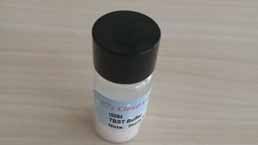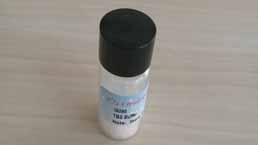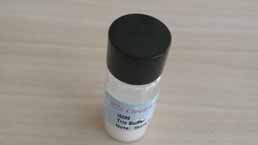Active Advanced Glycation End Product (AGE) 

AGEs; Advanced Glycation End Products
Overview
Properties
- Product No.APB353Ge01
- Organism SpeciesPan-species (General) Same name, Different species.
- ApplicationsCell culture; Activity Assays.
Research use only - DownloadInstruction Manual
- CategoryMetabolic pathwayEndocrinologyCardiovascular biologyHormone metabolism
- Buffer FormulationPBS, pH7.4, containing 5% Trehalose.
- Traits Freeze-dried powder, Purity > 90%
- Isoelectric Pointn/a
Sign into your account
Share a new citation as an author
Upload your experimental result
Review

Contact us
Please fill in the blank.
Activity test
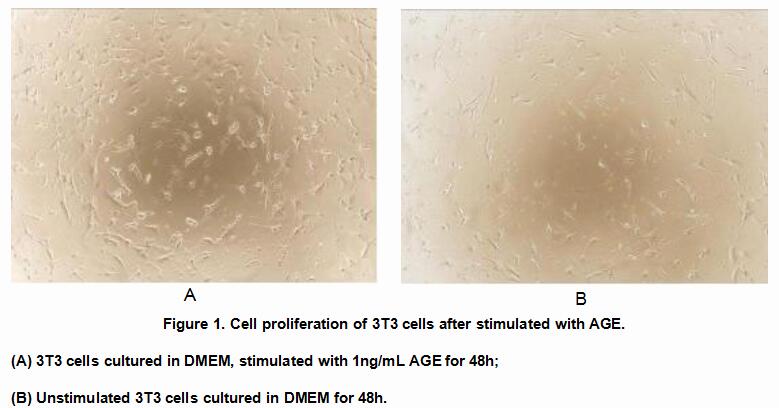
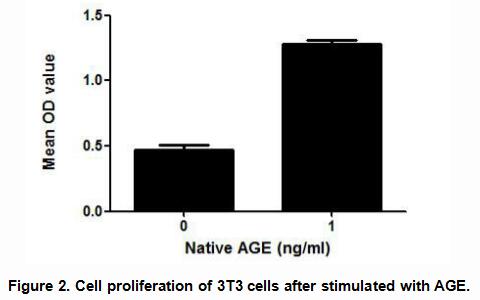
Glucose and other reducing sugars can react non-enzymatically with the amino groups of proteins to form compounds called advanced glycation end products (AGEs). AGEs exert their cellular functions via the interaction with receptor for advanced glycation end products (RAGE). It has been reported that AGE stimulates the differentiation and proliferation of 3T3, thus a proliferation assay was conducted using 3T3 cells. Briefly, 3T3 cells were seeded into triplicate wells of 96-well plates at a density of 2,000 cells/well and allowed to attach overnight, then the medium was replaced with serum-free standard DMEM prior to the addition of various concentrations of AGE. After incubated for 48h, cells were observed by inverted microscope and cell proliferation was measured by Cell Counting Kit-8 (CCK-8). Briefly, 10µL of CCK-8 solution was added to each well of the plate, then the absorbance at 450nm was measured using a microplate reader after incubating the plate for 1-4 hours at 37°C. Proliferation of 3T3 cells after incubation with AGE for 48h observed by inverted microscope was shown in Figure1. Cell viability was assessed by CCK-8 (Cell Counting Kit-8 ) assay after incubation with recombinant AGE for 48h. The result was shown in Figure 2. It was obvious that AGE significantly increased cell viability of 3T3 cells.
Usage
Reconstitute in PBS (PH7.4) to a concentration of 0.1-1.0 mg/mL. Do not vortex.
Storage
Avoid repeated freeze/thaw cycles. Store at 2-8°C for one month. Aliquot and store at -80°C for 12 months.
Stability
The thermal stability is described by the loss rate. The loss rate was determined by accelerated thermal degradation test, that is, incubate the protein at 37°C for 48h, and no obvious degradation and precipitation were observed. The loss rate is less than 5% within the expiration date under appropriate storage condition.
Increment services
Citations
- Threshold serum concentrations of tumour necrosis factor alpha (TNFα) as a potential marker of the presence of microangiopathy in children and adolescents with type 1 diabetes mellitus (T1DM)PubMed: S0198885912005642
- A long-standing hyperglycaemic condition impairs skin barrier by accelerating skin ageing processPubMed: 22017743
- Daily intake of vitamin D- or calcium-vitamin D-fortified Persian yogurt drink (doogh) attenuates diabetes-induced oxidative stress: evidence for antioxidative properties of vitamin D.Pubmed: 23829785
- Association of RAGE gene polymorphism with circulating AGEs level and paraoxonase activity in relation to macro-vascular complications in Indian type 2 diabetes mellitus patients.Pubmed: 23721855
- Lipoprotein-associated phospholipase A2 and AGEs are associated with cardiovascular risk factors in women with history of gestational diabetes mellitus.Pubmed:24397392
- Role of advanced glycation end product (AGE)-induced receptor (RAGE) expression in diabetic vascular complicationsPubmed:24984291
- Nitroxides prevent protein glycoxidation in vitro.Pubmed:25363554
- Serum advanced glycation end products are associated with insulin resistance in male nondiabetic patients with obstructive sleep apneaPubmed:25566941
- Ascorbic acid and protein glycationPubMed: 26163454
- Establishment of a rabbit model to study the influence of advanced glycation end products accumulation on osteoarthritis and the protective effect of pioglitazonePubMed: 26321377
- Relationship between serum levels of endogenous secretory RAGE and blood pressure in male nondiabetic patients with obstructive sleep apneaPubMed: 25994997
- Glycation of bovine serum albumin by ascorbatePubMed: 26202868
- Impact of morbid obesity and bariatric surgery on antioxidant/oxidant balance of the unstimulated and stimulated human salivaPubMed: 26608886
- Inhibition of Advanced Glycation Endproduct Formation by Lotus Seedpod Oligomeric Procyanidins through RAGE-MAPK Signaling and NF-κB Activation in High-Fat-Diet Rats.PubMed: 26207852
- ADVANCED GLYCATION END PRODUCTS'RESPONSE TO RESISTANCE TRAINING IN POSTMENOPAUSAL WOMEN WITH TYPE II DIABETES140251:
- Effects of edible bird's nest on hippocampal and cortical neurodegeneration in ovariectomized ratsPubMed: 25920003
- Beneficial effects of urine-derived stem cells on fibrosis and apoptosis of myocardial, glomerular and bladder cellsPubmed:26952874
- Effects of S-Nitroso-N-Acetyl-Penicillamine (SNAP) on Inflammation, Lung Tissue Apoptosis and iNOS Activity in a Rabbit Model of Acute Lung InjuryPubmed:27334732
- The Receptor for Advanced Glycation End Products (Rage) and Its Ligands in Plasma and InfrainCavia (Guinea pig )inal Bypass VeinPubmed:26905625
- Berberine exerts renoprotective effects by regulating the AGEs-RAGE signaling pathway in mesangial cells during diabetic nephropathy.pubmed:28087385
- Inhibition of Methylglyoxal-Induced AGEs/RAGE Expression Contributes to Dermal Protection by N-Acetyl-L-Cysteine.pubmed:28214842
- Glutathione is the main endogenous inhibitor of protein glycation.pubmed:28218612
- Establishment of a rabbit model to study the influence of advanced glycation end productsaccumulation on osteoarthritis and the protective effect of pioglitazone.pubmed:26321377
- Advanced glycation end products promote VEGF expression and thus choroidal neovascularization via Cyr61-PI3K/AKT signaling pathwaypubmed:29097668
- Lychee seed extract protects against neuronal injury and improves cognitive function in rats with type II diabetes mellitus with cognitive impairmentpubmed:29138799
- (台灣農業研究67 (4): 355-364) 香菇柄水萃物改善糖尿病降低阿茲海默氏症罹病風險初探
- Altered Mineral Metabolism and Disequilibrium Between Calcification Promoters and Inhibitors in Chronic Hemodialysis PatientsPubmed: 30847765
- Cellular Metabolomics Reveal the Mechanism Underlying the Anti-Atherosclerotic Effects of Aspirin Eugenol Ester on Vascular Endothelial DysfunctionPubmed: 31261711
- Fushiming Capsule Attenuates Diabetic Rat Retina Damage via Antioxidation and Anti-Inflammation
- Effect of Advanced Glycation End Products on the Progression of Alzheimer's DiseasePubmed: 31561370
- Protective effect of vanillin on diabetic nephropathy by decreasing advanced glycation end products in ratsPubmed: 31759039
- Supplementation with Korean Red Ginseng Improves Current Perception Threshold in Korean Type 2 Diabetes Patients: A Randomized, Double-Blind, Placebo …Pubmed: 32025522
- A New Insight into Meloxicam: Assessment of Antioxidant and Anti-Glycating Activity in In Vitro StudiesPubmed: 32927809
- Advanced glycation end products enhance macrophage polarization to the M1 phenotype via the HIF-1α/PDK4 pathwayPubmed: 32464167
- The effect of Korean Red Ginseng on sarcopenia biomarkers in type 2 diabetes patientsPubmed: 32470863
- The Role of PPARγ in Hyperglycemia-induced Deleterious Effect on Chondrocytes
- Young and Undamaged rMSA Improves the Healthspan and Lifespan of Mice34439857
- Dietary Advanced Glycation End Products Shift the Gut Microbiota Composition and Induce Insulin Resistance in MicePubmed:35210793












